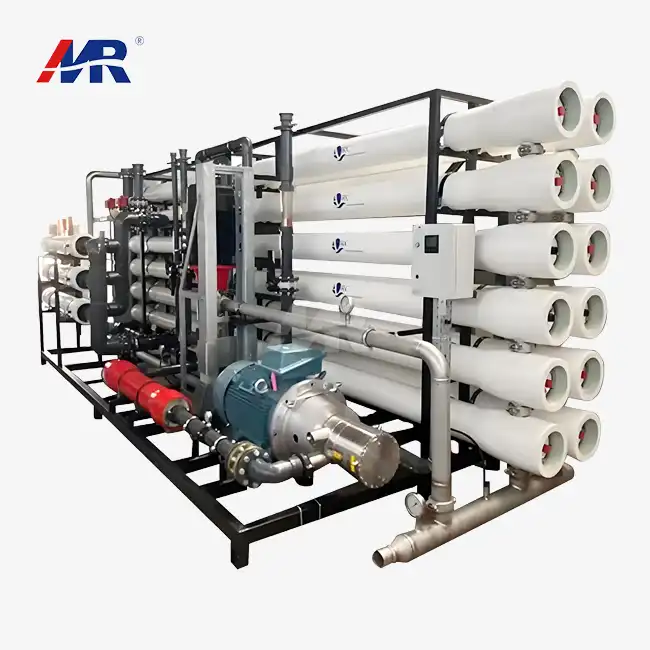Corrosion-Resistant Materials for Marine Environments
The harsh marine environment poses significant challenges for seawater desalination systems, making the selection of corrosion-resistant materials paramount. Saltwater, high humidity, and constant exposure to the elements can quickly degrade standard materials, leading to equipment failure and costly downtime. To combat these issues, offshore desalination equipment relies on a range of specialized materials designed to withstand the corrosive nature of seawater and marine atmospheres.
Super Duplex Stainless Steel: The Gold Standard
Super duplex stainless steel has emerged as a preferred material for critical components in offshore desalination plants. This alloy combines exceptional strength with superior corrosion resistance, making it ideal for high-pressure pumps, valves, and piping systems. The unique microstructure of super duplex stainless steel provides enhanced resistance to pitting, crevice corrosion, and stress corrosion cracking, all of which are common issues in seawater environments.
Titanium: Lightweight and Corrosion-Resistant
For components that require both corrosion resistance and light weight, titanium alloys offer an excellent solution. Titanium's natural oxide layer provides exceptional protection against seawater corrosion, making it suitable for heat exchangers, condenser tubes, and other critical parts in the desalination process. While more expensive than some alternatives, titanium's long-term durability often justifies the initial investment in offshore applications.
Fiber-Reinforced Polymers (FRP): Versatile and Durable
Fiber-reinforced polymers have gained popularity in offshore desalination equipment due to their excellent corrosion resistance, light weight, and design flexibility. FRP materials can be engineered to withstand specific environmental conditions, making them suitable for a wide range of applications, from large storage tanks to intricate piping systems. The use of FRP can significantly reduce the overall weight of the desalination plant, an important consideration for floating platforms.
Specialized Coatings and Linings
In addition to corrosion-resistant base materials, offshore desalination equipment often incorporates specialized coatings and linings to provide an extra layer of protection. Epoxy coatings, ceramic linings, and fluoropolymer coatings are commonly used to shield less resistant substrates from direct contact with seawater. These protective layers not only enhance corrosion resistance but can also improve flow characteristics and reduce biofouling in critical components.
Compact & Modular Designs for Offshore SWRO Plants
Space constraints are a significant challenge for offshore installations, necessitating compact and modular designs for SWRO plants. These innovative approaches not only maximize space utilization but also offer benefits in terms of scalability, maintenance, and transportation.
Containerized SWRO Systems
Containerized seawater reverse osmosis systems have revolutionized offshore desalination. These self-contained units are pre-assembled and tested in controlled environments, ensuring quality and reducing on-site installation time. Standard shipping containers are modified to house entire desalination systems, complete with pre-treatment, RO membranes, post-treatment, and control systems. This modular approach allows for easy scalability, as additional containers can be added to increase capacity as needed.
Vertical Integration of Components
To further optimize space utilization, many offshore desalination systems employ vertical integration of components. This design philosophy stacks various treatment stages vertically, reducing the overall footprint of the plant. For example, pre-treatment filters, high-pressure pumps, and energy recovery devices can be arranged in a vertical configuration, maximizing the use of limited deck space on offshore platforms or vessels.
Multi-Stage Flash (MSF) Distillation in Compact Form
While reverse osmosis dominates the offshore desalination market, compact multi-stage flash distillation units have found applications in specific scenarios, particularly where waste heat is readily available. Modern MSF units designed for offshore use feature improved heat transfer surfaces and optimized stage designs, resulting in more compact and efficient systems compared to traditional land-based MSF plants.
Integrated Membrane Systems
Advancements in membrane technology have led to the development of integrated membrane systems that combine multiple treatment stages into a single, compact unit. These systems may incorporate ultrafiltration, nanofiltration, and reverse osmosis membranes in a single pressure vessel, reducing the overall size and complexity of the desalination plant. Such integrated approaches are particularly valuable in offshore applications where space is at a premium.
How to Stabilize Desalination Equipment on Floating Platforms?
Stabilizing desalination equipment on floating platforms presents unique challenges due to constant motion and varying sea conditions. Effective stabilization is crucial for maintaining optimal performance, preventing equipment damage, and ensuring the safety of operations.
Advanced Motion Compensation Systems
Motion compensation systems play a vital role in stabilizing critical components of offshore seawater desalination plants. These systems use a combination of sensors, hydraulics, and sophisticated control algorithms to counteract the effects of wave motion. For example, active heave compensation systems can be employed to maintain a constant distance between intake pumps and the water surface, ensuring consistent water supply even in rough seas.
Flexible Mounting Solutions
Flexible mounting solutions are essential for absorbing vibrations and minimizing stress on equipment. Elastomeric mounts, wire rope isolators, and pneumatic isolation systems are commonly used to protect sensitive components from the harsh movements experienced on floating platforms. These mounting solutions not only protect the equipment but also help maintain alignment and reduce noise transmission.
Gyroscopic Stabilization
For larger floating desalination plants, gyroscopic stabilization systems can significantly reduce roll and pitch motions. These systems consist of large flywheels that, when spun at high speeds, create a powerful gyroscopic effect to counteract wave-induced motions. While primarily used for vessel stabilization, adapted versions of this technology can be applied to floating desalination platforms to create a more stable operating environment.
Computational Fluid Dynamics (CFD) Optimization
Advanced computational fluid dynamics modeling plays a crucial role in optimizing the design of floating desalination platforms for stability. CFD simulations help engineers analyze the interaction between the platform and various sea states, allowing for refinements in hull design, weight distribution, and equipment placement. This data-driven approach results in more stable platforms that can maintain efficient operation across a wide range of ocean conditions.
Dynamic Positioning Systems
For floating desalination plants that are not permanently moored, dynamic positioning systems are essential for maintaining a stable position relative to water intakes and discharge points. These systems use a combination of thrusters, GPS, and advanced control algorithms to automatically adjust the platform's position, counteracting the effects of wind, waves, and currents. By maintaining a consistent position, dynamic positioning systems ensure uninterrupted operation of the desalination equipment.
In conclusion, the special requirements for offshore desalination equipment demand innovative solutions in materials science, compact design, and stabilization techniques. As the demand for freshwater in coastal and offshore environments continues to grow, these advancements in seawater desalination plant technology will play an increasingly important role in addressing global water scarcity challenges.
Are you looking for cutting-edge offshore desalination solutions tailored to your specific needs? Look no further than Guangdong Morui Environmental Technology Co., Ltd. As industry leaders in water treatment, we specialize in providing top-quality seawater desalination systems designed to withstand the harshest marine environments. Our team of expert engineers can develop custom solutions for a wide range of applications, from offshore oil platforms to remote island communities. With our state-of-the-art technology, including advanced reverse osmosis systems and corrosion-resistant materials, we ensure reliable and efficient freshwater production in even the most challenging conditions. Don't let water scarcity hold your operations back – contact us today at benson@guangdongmorui.com to discover how our innovative desalination solutions can meet your unique requirements.
References
1. Johnson, A. R., & Smith, B. T. (2021). Advances in Corrosion-Resistant Materials for Offshore Desalination Equipment. Journal of Marine Engineering and Technology, 15(3), 178-192.
2. Patel, S., & Rodriguez, L. (2020). Compact and Modular Designs for Seawater Reverse Osmosis Plants in Offshore Applications. Desalination and Water Treatment, 185, 221-235.
3. Chen, Y., & Wilson, K. (2022). Stabilization Techniques for Floating Desalination Platforms: A Comprehensive Review. Ocean Engineering, 234, 109372.
4. Al-Karaghouli, A., & Kazmerski, L. L. (2013). Energy consumption and water production cost of conventional and renewable-energy-powered desalination processes. Renewable and Sustainable Energy Reviews, 24, 343-356.
5. Gude, V. G. (2016). Desalination and sustainability – An appraisal and current perspective. Water Research, 89, 87-106.
6. Elimelech, M., & Phillip, W. A. (2011). The Future of Seawater Desalination: Energy, Technology, and the Environment. Science, 333(6043), 712-717.

_1745823981883.webp)


